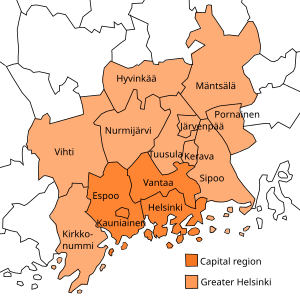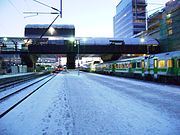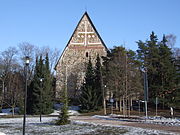User:Spitzmauskc/sandbox9
| This is a Wikipedia user page. This is not an encyclopedia article or the talk page for an encyclopedia article. If you find this page on any site other than Wikipedia, you are viewing a mirror site. Be aware that the page may be outdated and that the user in whose space this page is located may have no personal affiliation with any site other than Wikipedia. The original page is located at https://en.wikipedia.org/wiki/User:Spitzmauskc/sandbox9. |
Greater Helsinki[edit]
Greater Helsinki
| |
|---|---|
Metropolitan area | |
 Looking south over the Capital Region of Greater Helsinki toward the Gulf of Finland. | |
 | |
| Country | Finland |
| Region | Uusimaa |
| Area | |
| • Land | 3,698.99 km2 (1,428.19 sq mi) |
| • Capital Region | 771.04 km2 (297.70 sq mi) |
| Population (2023-12-31) | |
| • Total | 1,582,452 |
| • Density | 427.8/km2 (1,108/sq mi) |
| • Capital Region | 1,246,237 |
| Website | helsinkiregion.fi |
Greater Helsinki (Finnish: Helsingin seutu, Suur-Helsinki; Swedish: Helsingforsregionen, Storhelsingfors) is the metropolitan area surrounding Helsinki (Swedish: Helsingfors), the capital city of Finland. It includes the smaller Capital Region (Finnish: Pääkaupunkiseutu, Swedish: Huvudstadsregionen) urban area.
The smaller Capital Region consists of the central cities of Helsinki, Vantaa, Espoo, and Kauniainen and has a population of approximately 1.25 million. The Greater Helsinki region is the largest urbanised area in the country with 1,582,452[1] inhabitants and is by far the most important economic, cultural, and scientific region of Finland. Five out of Finland's 14 universities[note 1] and most of the headquarters of notable companies and governmental institutions are located in Greater Helsinki, as is Finland's main airline hub and airport, Helsinki Airport, which is located in Vantaa.
These regions are located in the south of Finland, on the coast of the Gulf of Finland, which is part of the Baltic Sea. They area a part of the region of Uusimaa.
The term "Helsinki Metropolitan Area" and the other terms used are not firmly established and may vary in different contexts. Greater Helsinki is sometimes incorrectly[clarification needed] called (the) Helsinki Region due to an incorrect direct translation of the Finnish and Swedish terms Helsingin seutu and Helsingforsregionen.
Terminology[edit]
Capital Region[edit]
In the strictest sense, the Finnish Capital Region consists of four municipalities with city title, Helsinki, Vantaa, Espoo and Kauniainen, whose total population is about 1.1 million (2014). This area is most often called the Capital region in English, Pääkaupunkiseutu in Finnish, and Huvudstadsregionen in Swedish, although the use of the terms is not especially consistent. The vast majority of the inhabitants live in the urban areas of the cities, but within the boundaries of these cities there are also suburban and rural areas.
Greater Helsinki[edit]
Commonly about ten more municipalities are considered to be part of Greater Helsinki, as they can be considered to be commuter towns and exurbs of Helsinki. When Hyvinkää, Järvenpää, Kerava, Kirkkonummi, Nurmijärvi, Sipoo, Tuusula, Mäntsälä, Pornainen and Vihti are included, the number of inhabitants rises to 1.4 million. All of the municipalities belong to the region of Uusimaa. Of these, Järvenpää, Kerava, Tuusula, Nurmijärvi, Sipoo, Kirkkonummi, Mäntsälä and Vihti have parts of the urban area within them. Additionally, the cities of Porvoo, Lohja, and to some extent Riihimäki, which have very close ties, motorway and (in the case of Riihimäki) commuter train accesses, and are fairly close to the capital, are nowadays often included in regional planning, which raises the total population to about 1,550,000.
Other definitions[edit]
As a part of the "Urban audit" project, Eurostat has attempted to standardise the concept of a 'metropolitan area'. According to this study the Metropolitan area of Helsinki consists of the kernel of Helsinki: Helsinki, Espoo, Vantaa, and Kauniainen. The Helsinki Larger Urban Area (Helsingin seutu in Finnish) consists of 12 cities and municipalities: the kernel of Helsinki and the aforementioned eight municipalities.[2]
Statistics Finland define the commuter belt of Helsinki (Helsingin työssäkäyntialue, Helsingfors pendlingsområde) to include a total of 24 municipalities, with a land area of 7,359.80 km2 and a population of 1,431,108 as of 31 December 2007.[3][4] In addition to that, there are people from as far as Lahti and even Tampere commuting to Helsinki daily.
Statistics Finland also defines the Helsinki urban area according to the official Finnish definion of an urban area (taajama in Finnish). Urban areas in Finland are defined as inhabited areas of at least 200 people with a maximum distance of 200 metres (660 ft) between buildings.[5][6] The Helsinki urban area is the largest of its kind in Finland, and encompasses land throughout Greater Helsinki, with notable gaps around forests and other less-densely populated areas.
Statistics[edit]
The table below lists population, area, and population density for the largest municipalities of the Greater Helsinki area. (Note that "Helsinki Metropolitan Area" and the other terms used are not firmly established and may vary in different contexts.) The commuter towns of Lohja and Porvoo are not usually included, though, if they were (considering their proximity to Helsinki and their high commuting rate), they would raise the overall population above 1.5 million people. Hyvinkää, Järvenpää, Nurmijärvi, Tuusula, Mäntsälä and Pornainen, which have been designated as municipalities in Central Uusimaa in recent decades, have shown clear population growth due to their urban but also loose rural environment. These are also known as "Kuuma-kunnat" (literally means "hot municipalities").[7]
| Municipality | Area | Population (2023-12-31) |
Population density |
|---|---|---|---|
| Helsinki | 214.42 km² | 674,500 | 3,145.7/km² |
| Espoo | 312.35 km² | 314,024 | 1,005.36/km² |
| Vantaa | 238.38 km² | 247,443 | 1,038.02/km² |
| Kauniainen | 5.89 km² | 10,270 | 1,743.63/km² |
| Capital region | 771.04 km² | 1,246,237 | 1,616.31/km² |
| Hyvinkää | 322.69 km² | 46,901 | 145.34/km² |
| Mäntsälä | 580.85 km² | 20,957 | 36.08/km² |
| Pornainen | 146.53 km² | 4,973 | 33.94/km² |
| Järvenpää | 37.54 km² | 46,490 | 1,238.41/km² |
| Kerava | 30.63 km² | 38,211 | 1,247.5/km² |
| Kirkkonummi | 366.6 km² | 41,154 | 112.26/km² |
| Nurmijärvi | 361.9 km² | 44,785 | 123.75/km² |
| Sipoo | 339.66 km² | 22,595 | 66.52/km² |
| Tuusula | 219.53 km² | 41,338 | 188.3/km² |
| Vihti | 522.02 km² | 28,811 | 55.19/km² |
| Commuter towns | 2,927.95 km² | 336,215 | 114.83/km² |
| Metropolitan area (Greater Helsinki) | 3,698.99 km² | 1,582,452 | 427.81/km² |
Government buildings[edit]
-
Soukanniemi, a peninsula in Espoo.
Transportation[edit]
-
Tikkurila railway station in Vantaa.
Housing[edit]
Natural areas and public spaces[edit]
-
A bog pond in Nuuksio National Park, situated 30 km (19 mi) from Helsinki city center in parts of Espoo, Kirkkonummi, and Vihti.
-
Docks in Haukilahti, Espoo at sunset.
-
Skiing and ice skating on Lake Tuusulanjärvi in Tuusula.
-
The Puistoblues Festival in Järvenpää, one of Europe's largest blues festivals.
Architecture[edit]
Medieval[edit]
-
The Espoo Cathedral, a medieval stone church constructed in the 1480s, the oldest preserved construction in Espoo.
-
Church of St. Lawrence in Lohja
-
Church of St. Lawrence in Vantaa, the oldest building in Greater Helsinki. Constructed in the 1450s, it was the seat of Helsinki Parish well before the the city of Helsinki was founded in 1550.
Religious buildings[edit]
-
Klaukkala church in Klaukkala, Nurmijärvi.
-
Hyvinkää kirrko, built in 1961.
-
Designed by Yrjö Sadeniuksen and constructed in 1895–96, the Hyvinkään vanha kirkko ('Hyvinkää Old Church') served as the main church of Hyvinkää parish until the
-
The Matasaari Chapel was built in 1993 on a small island in the south-western part of Espoo.
-
Suvelan kappeli, Espoo.
-
The Espoo Cathedral, a medieval stone church constructed in the 1480s, the oldest preserved construction in Espoo.
-
Church of St. Lawrence in Lohja
-
Church of St. Lawrence in Vantaa, the oldest building in Greater Helsinki. Constructed in the 1450s, it was the seat of Helsinki Parish well before the the city of Helsinki was founded in 1550.
See also[edit]
- Helsinki urban area
- Helsinki Metropolitan Area Libraries
- Largest European metropolitan areas
- Largest metropolitan areas in the Nordic countries
- List of urban areas in the Nordic countries
- Largest urban areas of the European Union
Notes[edit]
- ^ These are Aalto University, the University of Helsinki, the University of the Arts Helsinki, the Hanken School of Economics, and the National Defence University.
References[edit]
- ^ "City information and statistics". www.helsinginseutu.fi. Retrieved 2016-03-19.
- ^ http://circa.europa.eu/Public/irc/dsis/urbstat/library?l=/urban_audit_reports/urban_audit_2006/final_reportpdf_18/_EN_1.0_&a=d[permanent dead link]
- ^ Statistics Finland; Population by sex, area and change of population 31.12.2007; Commuter belts and municipalities 2008 [dead link] In Swedish, table unavailable in English. Accessed on 2008-09-08.
- ^ National Land Survey of Finland; pdf-file 'Pinta-alatilasto', downloadable from page. Archived 2011-05-20 at archive.today Areas of municipalities in Finland. Accessed on 2008-09-08.
- ^ "Taajamissa asuu 84 prosenttia väestöstä". Statistics Finland (in Finnish). 15 January 2008. Retrieved 20 February 2017.
- ^ Facta (encyclopedia) part 16, page 203, finnish
- ^ Kuuma.fi
















